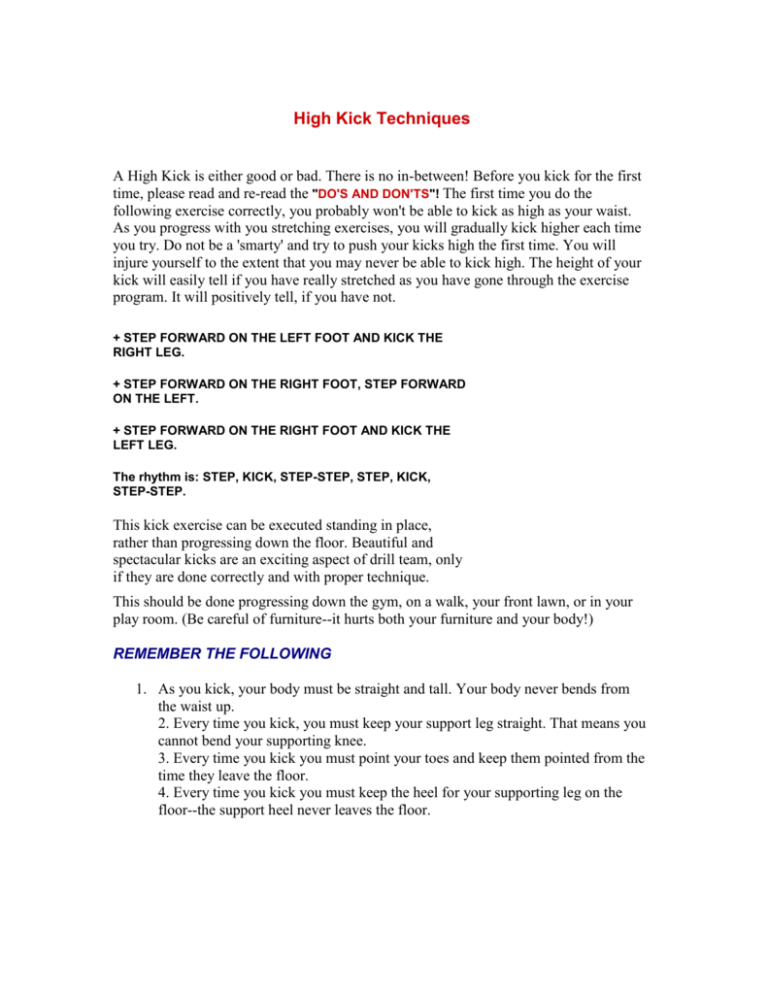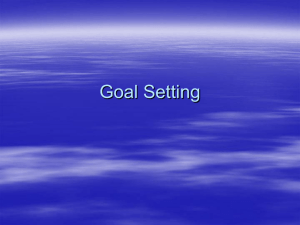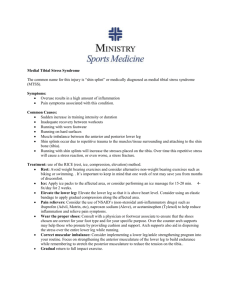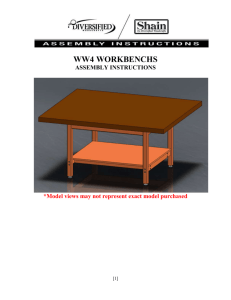High Kick Techniques
advertisement

High Kick Techniques A High Kick is either good or bad. There is no in-between! Before you kick for the first time, please read and re-read the "DO'S AND DON'TS"! The first time you do the following exercise correctly, you probably won't be able to kick as high as your waist. As you progress with you stretching exercises, you will gradually kick higher each time you try. Do not be a 'smarty' and try to push your kicks high the first time. You will injure yourself to the extent that you may never be able to kick high. The height of your kick will easily tell if you have really stretched as you have gone through the exercise program. It will positively tell, if you have not. + STEP FORWARD ON THE LEFT FOOT AND KICK THE RIGHT LEG. + STEP FORWARD ON THE RIGHT FOOT, STEP FORWARD ON THE LEFT. + STEP FORWARD ON THE RIGHT FOOT AND KICK THE LEFT LEG. The rhythm is: STEP, KICK, STEP-STEP, STEP, KICK, STEP-STEP. This kick exercise can be executed standing in place, rather than progressing down the floor. Beautiful and spectacular kicks are an exciting aspect of drill team, only if they are done correctly and with proper technique. This should be done progressing down the gym, on a walk, your front lawn, or in your play room. (Be careful of furniture--it hurts both your furniture and your body!) REMEMBER THE FOLLOWING 1. As you kick, your body must be straight and tall. Your body never bends from the waist up. 2. Every time you kick, you must keep your support leg straight. That means you cannot bend your supporting knee. 3. Every time you kick you must point your toes and keep them pointed from the time they leave the floor. 4. Every time you kick you must keep the heel for your supporting leg on the floor--the support heel never leaves the floor. "DON'TS" DO NOT bend forward as you kick. DO NOT bend supporting knees as you kick. DO NOT bend the leg that is kicking. DO NOT let the supporting heel come off the floor. DO NOT fail to point your toes. DO NOT start kicking down the floor without taking the time to warm up. "DO'S" DO keep your toe pointed on the kicking leg. DO keep the supporting knees straight all the time. DO keep the supporting heel on the floor. DO stretch before you kick. DO pull up your body as you kick. DO make sure your kick 'peeks' on even counts (say, "hit" as the kick reaches the peak) There are 15 points to watch for in good high kick technique Foot closure, head position, shoulder position, posture, tilting pelvis, hip alignment, straight supporting leg, heel down, toe points, kicks centered, control, tempo, leg extension, height of kick, leg distance from the body. If all these points are in good form and technique, you will have PERFECT kicks!! TIPS FOR WARMING UP Warming up is an integral part of every day rehearsal. It is important that your warm-up be structured, correct and consistent, utilizing all parts of the body. Extra warm-up time may be needed for certain muscle groups if they are to be used in an upcoming routine (ex., kicks, head rolls). The three main functions of a warm-up are: 1) to prepare the muscles to work, 2) to put the muscles through the range of flexibility needed in the actions to follow, and 3) to prepare the muscles for an increased output of strength. Some of your students may require extra warm-up time to increase their flexibility. You may need to write up a schedule for these pupils to do at home. The following tips will assist you in applying good warm-up techniques and maximum results: Have your officers "choreograph" a warm-up to popular music to use each day. Your team will find their exercises more fun. Change the music every 2 to 3 weeks. Make sure to exercise from head to toe (literally). Do not forget ankles, shoulders, head and neck, etc. These are areas sometimes overlooked but always very important. Remember that warming up is an injury prevention measure and cannot be omitted--ever! Be sure to stretch with good posture. Always pull up in the center of the body and stretch in straddle, pike and hurdle positions with a flat back, leading with the abdomen and not the chin or chest. Rounding the back will stretch and loosen back muscles instead of thighs or hips. Be sure that the legs do not roll in or out when in straddle or hurdle position. Knees and shoe laces to the sky! Stretch with toes flexed for 1/2 of the time and pointed 1/2 of the time. This will add extra stretch to muscles in the other parts of the leg in addition to the hamstring. BASIC STRETCHING Stretches should be a standard part of every drill team warm-up. When executed properly these exercises can improve your team's overall performance abilities. The following stretching exercises are simple and can be performed by even the most basic beginner. STRETCH #1 Sitting in a semi-yoga or soles of the feet together, position arms over the knee. Bend forward stretching the lower back muscles. Repeat several times. STRETCH #2 Sitting with legs straight forward and the knees straight but not locked. Bend the torso over the legs trying to reach the rib cage toward the thighs. Later, the hands can grab the ankles to aid in reaching greater flexibility. STRETCH #3 Sit with the legs extended to each side. Bend to the side over one leg. Have the upper arm stretch side over the head and the lower arm can relax along the floor. Keep both hips (buttocks) on the floor. STRETCH #4 As in the above exercise, bend over the leg, but rotate the torso to face the leg. The arms can reach over the leg and later try to reach beyond the toes. STRETCH #5 Standing, cross one leg over the other and keep the toes pointing forward. Bend forward reaching the hands toward the floor stretching the hamstring muscles. Later grab the ankles and pull the rib cage closer to the thighs. STRETCH #6 Standing fairly close to the wall and leaning into the wall, press the heels to the floor stretching the Achilles tendon and calf muscles. Later, after flexibility increases, move further away from the wall. Increase difficulty of stretches by 1) changing tempo and # of stretches; 2) change the direction of the stretch forward, to the side, backward, and diagonally forward; 3) combine different stretches with various directions. EXERCISES FOR HIGH KICKS Beautiful and spectacular kicks are an exciting aspect of dance/drill team. However, to be most effective, they must appear effortless in quality and still posses the burst of energy which they demand for execution. The following exercises are designed to increase the flexibility and strength of high kicks: EXERCISE #1 Lie on your back, one leg extended, bringing the knee of the other leg close into the chest. Extend the knee, straightening the leg into the air. DO NOT hold the leg in back of the knee for fear you could strain the tendons that run in the back of your knee. Try to hold around the calf or upper thigh area. Using both hands to hold the leg, point and flex the foot 4 to 8 times, then repeat the exercise with the other leg. EXERCISE #2 Sitting in a straddle position (open wide to sides). The torso should be up straight and keeping the knees pointing upward. The heels stay in place and the ankles flex as the knees lift. Then reverse the process and extend the ankles and the knees. The arm can be placed in any upward or side position. Be sure the arms and hands remain relaxed and free of tension. Repeat this exercise several times. EXERCISE #3 Sitting in a hurdle position with one leg bent in front and the other extended forward and front. Keeping both hips (buttocks) on the floor, bend the torso forward over the extended forward leg, then return the body to the beginning position. Repeat this exercise 4 to 8 times then change legs. The arms can start over the head and go with the body as it bends over the leg. EXERCISE #4 Sit in a double hurdle or "S" position (both knees bent, one leg in front and the other in back). Keeping the back straight, raise the back leg bringing it to the side of the body. The leg will not go very high, but hold for 8 counts and return to the beginning position. Do 2 to 4 on one leg, then repeat on the other side. The arms can be held out to the side when the leg raises to the side. EXERCISE #5 Sit with one leg in front and raise the other leg into the air with your hand. Try to pull the heel as close to your face as possible. To bring the leg back down, bring it forward then bend the knee to fully recover the leg. Repeat this exercise 3 to 5 times, then try the other leg. Later, try to perform this exercise without the use of the hand holding the heel. EXERCISE #6 Standing facing the wall, bring the knee up and lean back to get the foot placed on the wall (you may need to work in pairs for this exercise). Slowly slide the foot up the wall until the knee is straight, keeping the back and supporting leg straight as the leg goes up the wall. As flexibility improves, move closer to the wall. Bring the leg down by swinging it to the side. This exercise can be repeated with the leg to the side and back as it is extended against the wall.







